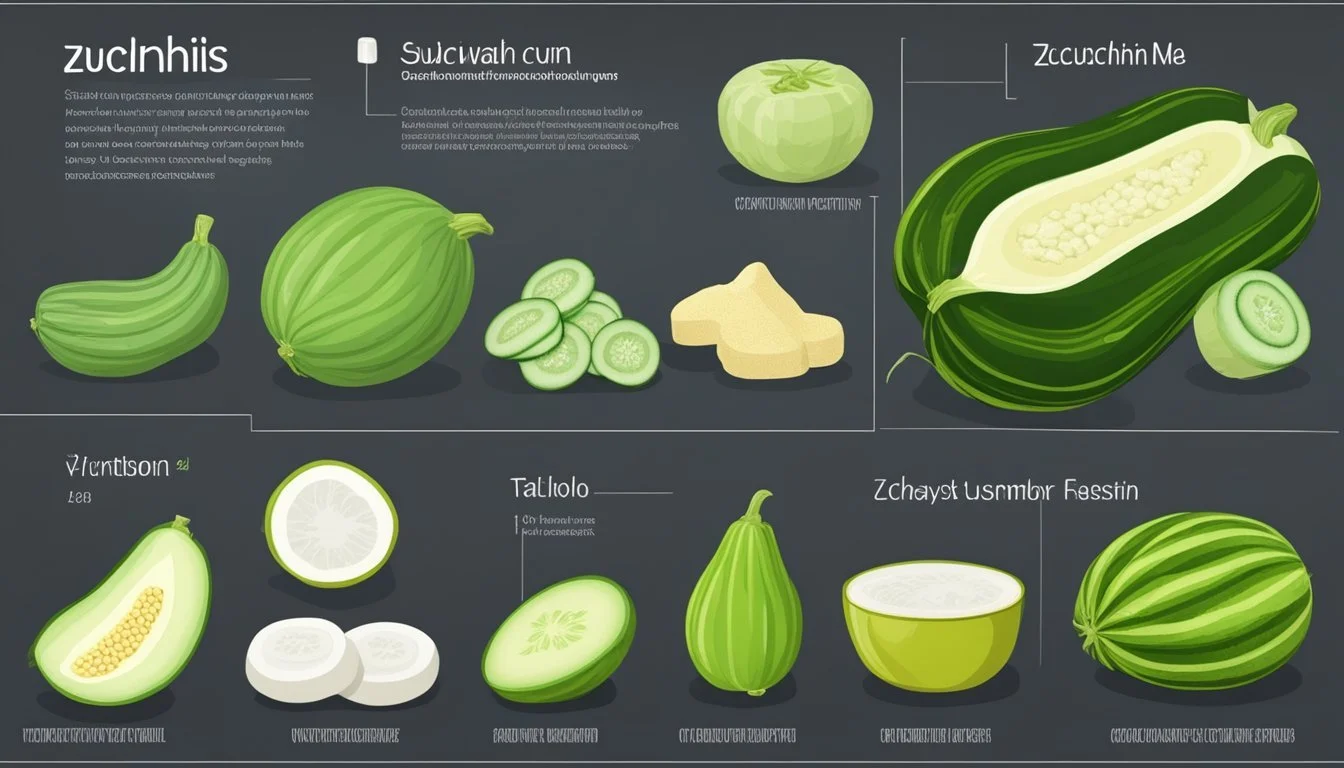Wax Gourd Substitutes
Best Alternatives for Cooking
For those who love Chinese cuisine or experimenting with different vegetables in their cooking, finding the perfect substitute for wax gourd can elevate your dishes to new heights. If you can't find wax gourd, also known as winter melon or ash gourd, substitutes such as fuzzy melon or even certain types of squash can deliver similar textures and mild flavors. This can be especially useful when you want to replicate Asian recipes that traditionally rely on this versatile ingredient.
Wax gourd's mild taste makes it a great addition to soups and other dishes where it absorbs the flavors of the surrounding ingredients. Its unique texture is difficult to replicate, but alternatives like zucchini or cucumber may bring you close. Some substitutes not only match its culinary characteristics but also offer similar nutritional benefits, such as being fiber-rich and vitamin-rich.
Exploring different substitutes opens up creative possibilities in your cooking repertoire, enabling you to experiment with similar textures and flavors. Imagine the delight of creating your favorite dishes even when wax gourd is out of season or unavailable in your local market. Stay tuned as we dive deeper into the best wax gourd substitutes and how to use them effectively in your kitchen.
Understanding Wax Gourd
Wax gourd (Benincasa hispida), also known as winter melon, is an essential ingredient in many Asian cuisines. This versatile gourd offers various culinary applications and possesses significant nutritional benefits.
Botanical Profile
Wax gourd belongs to the Cucurbitaceae family. Its scientific name is Benincasa hispida. The plant thrives in warm climates and typically grows on vines that can extend over 12 feet. The gourd itself is large, with a characteristic waxy coating that aids in long-term storage. It’s usually green with white flesh inside. Farmers prefer sowing seeds in well-drained soil and often use a trellis to support its sprawling growth. Once mature, it’s a nutrient-rich vegetable.
Culinary Uses
In the kitchen, wax gourd is highly versatile. It can be used in soups, stews, stir-fries, and even desserts. The flesh absorbs flavors well, making it ideal for savory broths. It is often cooked with meats, shrimp, or tofu. Before cooking, the thick green skin is peeled off, and the white, spongy flesh is cubed or sliced. Notably, wax gourd should always be cooked as it is not palatable raw. The seeds are generally discarded, though they can be roasted and eaten in some culinary traditions.
Nutritional Value
Wax gourd is packed with essential nutrients. A 100-gram serving provides:
Nutrient Amount Vitamin C 13.9 mg Calcium 19 mg Magnesium 10 mg Iron 0.4 mg Zinc 0.2 mg Fiber 0.6 g Protein 0.6 g
It’s also low in calories and fat, making it a suitable addition to weight-conscious diets. The high water content helps in hydration, and the fiber aids digestion. Additionally, the presence of vitamins and minerals such as calcium and magnesium contributes to overall health, including bone strength and metabolic functions.
Wax Gourd in Asian Cuisine
Wax gourd, also known as winter melon, plays a significant role in various Asian cuisines, particularly in Chinese dishes. It is renowned not only for its culinary uses but also for its applications in traditional medicine. Below, discover how wax gourd enhances traditional remedies, features in popular recipes, and is celebrated in holiday feasts.
Traditional Chinese Medicine
In Traditional Chinese Medicine (TCM), wax gourd is valued for its cooling properties. Healers use it to alleviate heat-related conditions and to promote diuresis. Winter melon is often incorporated into herbal teas and broths intended to soothe inflammation and detoxify the body. Its mild, slightly sweet taste makes it an effortless addition to various medicinal preparations.
Asian supermarkets stock fresh and dried forms of wax gourd. The dried version is particularly cherished for making winter melon tea, a popular health drink in Southeast Asia. This tea is appreciated for hydrating the body and assisting in weight management.
Common Recipes
Wax gourd is a versatile ingredient in many Asian cuisines. Among its most beloved dishes is the winter melon soup, which combines the gourd with subtle flavors like ginger, pork, or shrimp. This soup is often served in Chinese cuisine, cherished for its light and refreshing qualities.
In addition to soups, wax gourd finds its way into stir-fried dishes and refreshing salads. It acts as a perfect counterpart to bold flavors like fermented black beans or tangy Korean tuna sauce. Its adaptability allows it to absorb the flavors of the ingredients it is cooked with, making it a favorite in family kitchens.
Role in Holiday Dishes
During festive seasons, wax gourd makes notable appearances in celebratory meals. In Chinese New Year feasts, it symbolizes prosperity and good health. Dishes like stuffed wax gourd, where the gourd is filled with a mixture of meats, mushrooms, and lotus seeds, are popular.
In Indian and Southeast Asian traditions, wax gourd is used in sweets like petha, a candied preparation. This delicacy, often served during festivals, highlights the gourd's versatility and enduring popularity in regional cuisines.
Wax Gourd Substitutes
When looking for alternatives to wax gourd, various vegetables and fruits can be used based on texture, flavor, and nutritional content. Each substitute offers unique characteristics that make them suitable for different recipes.
Similar Texture Substitutes
For those aiming to replicate the texture of wax gourd, fuzzy melon and cucumber are excellent choices.
Fuzzy melon has a firm yet tender texture that resembles wax gourd when cooked. It works well in soups and stews, absorbing flavors nicely. Cucumber, particularly when peeled and deseeded, can mimic the crunchy, watery texture of wax gourd in salads and light dishes.
Other options include zucchini and summer squash, both of which maintain a similar texture when cooked, providing a suitable stand-in for wax gourd in various recipes.
Flavor Profile Substitutes
The mild, subtle taste of wax gourd can be closely matched with cucumbers and zucchinis.
Cucumbers offer a refreshing, slightly sweet flavor that blends seamlessly into soups and salads. Zucchinis have a mild taste that does not overpower other ingredients, making them versatile in both sweet and savory dishes.
For a slightly sweeter option, watermelon rind can be used after removing the tough outer skin and green layer, tapping into its subtle sweetness and crisp texture. This can be particularly effective in pickles or stir-fries.
Nutritionally Similar Substitutes
From a nutritional standpoint, fuzzy melon and cucumber are low-calorie, high-water content vegetables similar to wax gourd.
Fuzzy melon provides fiber and essential vitamins, while maintaining a low-calorie count. Cucumber is predominantly water, aiding in hydration, and also offers small amounts of vitamins and minerals.
Another option is zucchini, which is also low in calories and rich in vitamins A and C. This makes it a health-conscious alternative that aligns closely with the nutritional benefits of wax gourd.
By selecting vegetables that closely match the texture, flavor, or nutritional profile of wax gourd, cooks can adapt recipes seamlessly, ensuring delicious and balanced dishes.
How to Choose and Store Substitutes
Selecting and storing substitutes for wax gourd can ensure that you maintain the integrity and flavor of your dish. Key points include picking the right alternatives and storing them properly.
Selecting the Best Alternatives
When choosing substitutes for wax gourd, consider texture and moisture content. Fuzzy melon can be a suitable substitute as it has a similar texture and can handle similar cooking methods.
Chayote is also a good option due to its mild flavor and comparable cooking versatility.
Look for fresh, firm produce without any soft spots or discoloration. Ensure that the substitutes are free of blemishes and feel heavy for their size to guarantee freshness.
Storage Tips for Longevity
Proper storage is crucial to maintain the freshness of substitutes. For fuzzy melon and chayote, store them in the crisper drawer of your refrigerator. They can last up to a week, provided they are kept at the right temperature.
Before storing, clean the substitutes by washing off any dirt. Pat them dry to prevent moisture buildup, which can lead to spoilage.
For long-term storage, consider freezing diced or sliced portions. Blanching before freezing can help maintain their texture and color. Label the storage bags with the date to keep track of their freshness.
Preparation Techniques for Substitutes
Different substitutes for wax gourd can be prepared using a variety of methods. Each technique brings out distinct flavors and textures, making it easy to incorporate the substitutes into various dishes.
Cooking Methods
Cooking methods such as stir-frying, simmering, steaming, and parboiling are essential when preparing wax gourd substitutes.
Stir-Frying is quick and preserves the crunchiness of the vegetables. Use a hot pan and some oil, tossing the sliced substitutes until they are tender yet crisp.
Simmering suits recipes like stews. Cut the vegetable into chunks, then simmer in broth or sauce until soft and infused with the flavors.
Steaming is ideal for preserving nutrients. Place sliced substitutes in a steamer basket and cook them for 5-10 minutes until tender.
Parboiling helps to soften the vegetable without fully cooking it. Briefly boil the sliced pieces in salted water for a few minutes, then drain.
Serving Suggestions
Substitutes can be enjoyed in multiple settings, whether in salads, stews, or fried dishes.
For salads, use crisp substitutes like cucumber or zucchini. Slice thinly and toss with other fresh ingredients and a light dressing.
Stews benefit from hearty substitutes such as fuzzy melon or pumpkin. Add these in toward the end of cooking to maintain some firmness.
Fried options, including deep-frying or pan-frying, lend a satisfying crunch. Dip slices in batter and fry until golden, or simply sauté in a skillet with garlic.
Each method and suggestion ensures that the substitute maintains the desired texture and flavor in your dish.
Health Benefits and Dietary Considerations
When considering substitutes for wax gourd, it is essential to understand their health benefits and dietary implications. Substitutes should maintain the low-calorie content, richness in antioxidants, and dietary impact similar to wax gourd.
Low-Calorie Options
Wax gourd is known for being low in calories, making it an excellent choice for those managing weight. Substitutes such as cucumber, zucchini, and chayote also offer low-calorie options.
For example, cucumber contains about 16 calories per cup, while zucchini has around 19 calories per cup. These vegetables provide a similar caloric intake, making them suitable replacements in recipes where calorie control is crucial.
Moreover, the high water content in these substitutes aids hydration and promotes satiety without significantly increasing caloric intake. This characteristic is beneficial for maintaining a balanced diet and managing appetite.
Richness in Antioxidants
Antioxidants play a vital role in reducing oxidative stress and preventing chronic diseases. Wax gourd contains a variety of antioxidants, including vitamin C and flavonoids, contributing to its health benefits.
Substitutes like ash gourd, bitter melon, and bottle gourd also contain significant amounts of antioxidants. Ash gourd is rich in vitamins A and C, which help combat free radicals.
Bitter melon provides compounds like charantin and momordicin, known for their antioxidant properties. Incorporating these substitutes can ensure the continued intake of beneficial antioxidants, thereby supporting overall health and reducing the risk of illness.
Dietary Impact of Substitutes
Substituting wax gourd with other vegetables can impact dietary fiber, minerals, and overall nutritional balance. For instance, bottle gourd offers dietary fiber similar to wax gourd, aiding digestion and maintaining healthy cholesterol levels.
Chayote is another excellent substitute, providing essential nutrients such as vitamin C, folate, and manganese. Its mild flavor and versatility in cooking make it a suitable alternative in a variety of dishes.
Zucchini and cucumber are rich in potassium and vitamin K, supporting cardiovascular health and bone strength. These choices can help maintain a diet rich in crucial minerals and vitamins while ensuring the benefits of wax gourd are not lost.
Integrating Substitutes into Different Cuisines
Using substitutes for wax gourd can enhance the versatility and flavor of various dishes. The choice of substitute depends on the cuisine and the role the gourd plays in the dish.
Substitutes in Asian Cuisine
In Asian cuisine, fuzzy melon and cucumber often replace wax gourd. Fuzzy melon, resembling a hairy zucchini, is a great substitute due to its similar texture and mild flavor.
Chinese Cuisine benefits from fuzzy melon in soups and stews, preserving the authentic taste and consistency. Cucumbers, peeled and deseeded, can be used in stir-fries for a refreshing alternative.
Indian Food utilizes bottle gourd, which blends well with spices in curries and sabzis. This Cucurbitaceae family member has a mild tenderness that complements rich sauces.
Substitutes in Western Cuisine
Western dishes can incorporate substitutes like zucchini or summer squash when wax gourd is unavailable. Zucchini, with its tender flesh, works well in casseroles and side dishes.
In stews, summer squash holds up through prolonged cooking, absorbing flavors from broths and seasonings. Its mild taste ensures it doesn’t overpower other ingredients, making it a versatile option.
Stuffed vegetable recipes also gain from summer squash’s structure and consistency. Its ability to absorb flavors while maintaining shape makes it ideal for hearty, savory dishes.
Fusion Cooking
For fusion cooking, combining various substitutes allows chefs to experiment with textures and flavors. Use a mix of cucumbers and fuzzy melon in salads to create a blend of crunch and softness.
Zucchini can replace wax gourd in Asian-inspired stir-fries, offering a familiar Western touch. Bottle gourd can find its way into contemporary dishes like vegetable medleys, merging traditional tastes with modern styles.
These substitutions bring a unique twist, encouraging culinary creativity while maintaining a dish’s integrity and essential characteristics. Integrating diverse substitutes broadens the scope of recipes, inviting innovation.








